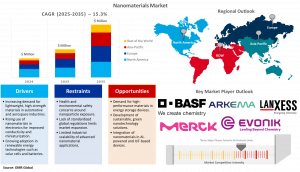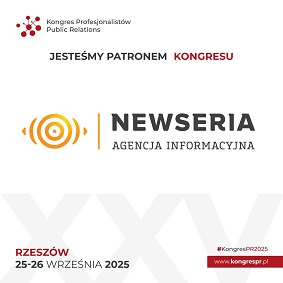Nanomaterials Market forecast to grow at 15.3% CAGR through 2035
Government funding in nanotechnology research and favorable R&D incentives is fast-tracking market growth across developed economies.
INDORE, INDIA, May 21, 2025 /EINPresswire.com/ -- Nanomaterials Market was valued at $12.7 billion in 2024 and is anticipated to grow at a CAGR of 15.3% during the forecast period (2025-2035). Nanomaterials have a unit size of 1 to 100 nanometers that can occur naturally, be produced as combustion reaction byproducts, or be designed to perform a particular function. The demand for nanomaterials is being driven by advancements in nanotechnology and increasing demand in different industries such as healthcare, electronics, and energy. Their properties, including high strength, light weight, and enhanced electrical and thermal conductivity, render them useful for use in batteries, semiconductors, and drug delivery devices. Greater concern with sustainable technologies results in an expanding use of these in renewable energy technologies and in systems of purification. For instance, in April 2024, SiAT said it is entering into a joint venture with Japan's Zeon Corp. to launch a new single-walled carbon nanotube (SWCNT) conductive paste that enhances lithium-ion battery efficiency. The new nanomaterial uses much less than traditional carbon black and has improved energy density and charging speed. Various government investment in nanotechnology research and rising usage in the automotive and aerospace industries increases the growth rate of the nanomaterials market.Click To get a Sample PDF (Including Full TOC, Graphs & Charts, Table & Figures) @
https://www.omrglobal.com/request-sample/nanomaterials-market
Market Trends
Technological Advancements in Nanotechnology
Technological innovation in nanotechnology is significantly fueling the expansion of the nanomaterials industry by improving the processes utilized in making the materials. Advanced processes of manufacturing that include bottom-up methods, such as molecular assembly, and top-down methods, such as nanolithography, have enhanced manufacturing scalability and reduced the cost-effectiveness of the production of nanomaterials. For instance, in August 2024, VSParticle, a Dutch startup company, got €6.5 million ($7 million) in funding for creating nanotechnology-based tools by NordicNinja that leads to material development time from a decade to 12-14 months. This effectiveness not only increases innovation, although decreases costs, particularly when handling limited materials. These advancements highlight the fast exploitation of nanomaterials in most industries, fueling massive growth in the market as businesses aim to utilize these cutting-edge technologies for competitiveness.
Increasing Demand from Healthcare and Biotechnology
Nanomaterials play a strategic role in healthcare and biotechnology as they are utilized in imaging diagnostics, drug delivery, and biosensors. The molecular-level interaction between the nanomaterials and biological systems has led to innovative targeted therapies and precisely accurate diagnostic strategies, leading to unprecedented growth of the healthcare market. According to HBM Healthcare Investments, sales of the international healthcare market will surpass $4 trillion annually. Pharmaceuticals and biotechnology are the largest and most lucrative sub-markets, with a combined value of almost $850 billion, with medical technology and diagnostics comprising over $400 billion. Nanomaterials enabled further development of drug delivery systems, diagnostic imaging, and biosensors are included in the high-value segments that drive demand and innovation which contributing to the overall growth of the industry.
Order Your Report Now For A Swift Delivery: https://www.omrglobal.com/buy-now/nanomaterials-market
Regional Outlook
Asia-Pacific to dominate the Nanomaterials Market
Asia Pacific led the global nanomaterials market with the major market share. This is primarily attributed to the fast growth of the semiconductor market along with the high production of semiconductor devices. Nanoscale size allows nanomaterials to offer better functionalities and features in the production of semiconductors. Higher usage of medical devices and consumer electronics further accelerated regional market growth. Additionally, the growing investments in research and development activities of nanomaterials to discover new areas of application will surge the market. For instance, in August 2024, the government of Karnataka, department of science and technology, Karnataka Science & Technology Promotion Society (KSTePS), and Jawaharlal Nehru Centre for Advanced Scientific Research (JNCASR) hosted the 13th Bengaluru India Nano Conference, this conference was themed as ‘Nanotechnology for Sustainability: Climate, Energy, and Healthcare’ to boost advancement in nanotechnology. This shows how the government of India encourages and supports manufacturing companies through several initiatives.
The United States has a significant share of Nanomaterials market in North America
The growth of the U.S. nanomaterial market is fueled mainly by investments under the National Nanotechnology Initiative (NNI), a broad R&D program initiated by the U.S. government. NNI has engaged more than 20,000 scientists in the research in the advancement and application of nanomaterials and has initiated immense progressions in the domain. Over the past two decades, NNI, under several government agencies and departments, has invested more than $38 billion in nanotechnology. Such investments are important for the fulfillment of nanoscience potential and have led the U.S. to a leadership position in nanomaterial innovation globally. The NNI facilitates collaboration between government, industry, and academia, hence advancing the commercialization of nanomaterial-based technologies across all healthcare, electronics, energy, and manufacturing sectors. Thus, the continuous flow of financing and research funds improves the application of nanomaterials, hence fostering the growth of the U.S. nanomaterial market. This indicates that the U.S. government has a crucial role in creating nanotechnology and maintaining its lead in the international market.
Market Segmentation and Growth Areas
Carbon-Based Nanomaterials to Become a Larger Segment
Carbon nanomaterials represent a group of carbon allotropes comprising 0-dimensional fullerenes and quantum dots, 1-dimensional carbon nanotubes (CNTs), 2-dimensional graphene, and 3-dimensional nanodiamonds and nanohorns. Carbon nanoparticles are used in a variety of applications owing to their distinct physical and chemical properties, such as biomedicine, semiconductors, batteries, sensors, and others. Although carbon nanotubes are extensively utilized in biological applications because of their varied characteristics. It possesses the most desirable potential for delivering anticancer drugs, DNA, and proteins for chemotherapy and is hence the most in-demand nanomaterial in the healthcare sector.
Healthcare is the Dominant End-User Segment
Nanomaterials play a pivotal role in numerous medical applications such as imaging, targeted drug delivery, nanorobotic surgery, nano diagnostics, cell repair, and nano biosensors. The need for nanomaterials is expected to remain strong since their use as T2 contrast agents in MRI scans that leverage their superparamagnetic ability at room temperature. Additionally, nanoparticles are used as carriers of genes in gene therapy and perform a vital role in the process of detoxification in the body.
Market Limitations and Challenges
• Toxicity and Safety Issues: Nanomaterials may interact unpredictably with biological systems in several ways, raising concerns regarding toxicity, bioaccumulation, and long-term environmental effects. Regulators are thus cautious, tending to further safety evaluations. These health and environmental uncertainties restrict market confidence and postpone commercial approvals, particularly in sensitive marketplaces such as food, medicine, and personal care.
• Regulatory Complication: Nanomaterials are regulated under varying regional frameworks, such as REACH (EU), TSCA (U.S.), and others. Each has its own set of requirements, posing legal and compliance issues for multinational companies. These regional differences add costs, slow product launches, and introduce uncertainty in cross-border trade, especially for small-to-medium-sized businesses without regulatory knowledge.
Market Players Outlook
Some of the major players operating in the global nanomaterials market include BASF SE, Merck KGaA, Evonik Industries AG, LANXESS Corp., and Arkema Group, among others. Players in the market are highlighting leveraging growth by implementing strategies such as collaboration, partnerships, and expansion in the market, among others. For instance, in December 2024, several initiatives were taken by the Ministry of Electronics and Information Technology (MeitY) to encourage research and innovation in nanoelectronics in India. This depicts government efforts and initiatives to advance the nanomaterial industry.
Request for Customization: https://www.omrglobal.com/report-customization/nanomaterials-market
Recent Developments
• In November 2024, a novel sensor based on nano-patterned copper oxide was introduced for ultra-low hydrogen detection. This technology is designed to improve safety precautions in a wide range of applications, especially in industrial settings.
• In August 2024, Image Core Lab launched its CLINSpa software that streamlines the clinical imaging process in medical trials. The innovative platform supports image acquisition, centralized analysis, and reporting, making clinical research more efficient.
• In February 2024, the minister of electronics and information technology (MeitY) secretary, S Krishnan, and officiating director at IIT Guwahati, Rajeev Ahuja, opened the Center of excellence on Smart Wearable Advanced Nano Sensing Technologies in Healthcare ACISs (SWASTHA) and state-of-the-art ISO five and six clean room facilities at the institute's center of nanotechnology department.
• In February 2024, at Johns Hopkins University, the Whiting School of Engineering and the Applied Physics Laboratory announced the advancement of a new biocompatible nanocomposite material to treat Retinitis pigmentosa by targeting the brain's visual cortex.
Some of the Key Companies in the Nanomaterials Market Include-
• Altair Nanotechnologies Inc.
• Arkema Group
• BASF SE
• Bayer AG
• Cytodiagnostics, Inc.
• Daikin Industries Ltd
• DuPont de Nemours, Inc.
• EMFUTUR Technologies
• Evonik Industries AG
• Frontier Carbon Corp.
• LANXESS Corp.
• LG Chem Ltd.
• Merck KGaA
• Nanoco Technologies Ltd.
• Nanocomposix, Inc.
• NANOCYL S.A.
• Nanoshel LLC
• SkySpring Nanomaterials Inc.
• Strem Chemicals, Inc.
• Umicore N.V.
• US Research Nanomaterials, Inc.
• Quantum Materials Corp.
Nanomaterials Market Segmentation Analysis
Global Nanomaterials Market by Material Type
• Carbon-Based
• Metal Based
• Dendrimers-Based
• Composite Segments
Global Nanomaterials Market by End-User
• Transportation
• Electrical & Electronics
• Healthcare
• Construction & Coatings
• Packaging
• Consumer Goods
• Energy
Regional Analysis
• North America
o United States
o Canada
• Europe
o UK
o Germany
o Italy
o Spain
o France
o Rest of Europe
• Asia-Pacific
o China
o India
o Japan
o South Korea
o ASEAN Economies (Singapore, Thailand, Vietnam, Indonesia, and Other)
o Australia and New Zealand
o Rest of Asia-Pacific
• Rest of the World
o Latin America
o Middle East and Africa
Inquiry Before Buying: https://www.omrglobal.com/inquiry-before-buying/nanomaterials-market
Anurag Tiwari
Orion Market Research Pvt Ltd
+ +91 91798 28694
email us here
Visit us on social media:
LinkedIn
Facebook
X
Legal Disclaimer:
EIN Presswire provides this news content "as is" without warranty of any kind. We do not accept any responsibility or liability for the accuracy, content, images, videos, licenses, completeness, legality, or reliability of the information contained in this article. If you have any complaints or copyright issues related to this article, kindly contact the author above.
Technical Overview of the leagend TC101 Android Thermal Imager
Medical Supplierz Adds Real-Time Quote Request Feature to Improve Buyer-Supplier Communication
Japan Probiotic Food Supplement Market Set To Grow 686.86M Through 2027 | Market Overview
Więcej ważnych informacji
 Jedynka Newserii
Jedynka Newserii

 Jedynka Newserii
Jedynka Newserii

Bankowość

Rośnie liczba i wartość udzielonych konsumentom kredytów gotówkowych. Gorzej mają się kredyty ratalne oraz te udzielane firmom
Rynek kredytowy w Polsce co do zasady rośnie, choć nierównomiernie. Z danych Biura Informacji Kredytowej wynika, że najlepiej rozwija się segment kredytów gotówkowych dla konsumentów. Wartościowo wzrosła też kwota udzielonych limitów w kartach kredytowych. Według prognoz BIK w całym roku wzrośnie wartość zarówno udzielonych kredytów mieszkaniowych, jak i gotówkowych, choć tych pierwszych poniżej inflacji. Wcześniejsze cięcia stóp procentowych przez RPP nie zmieniły tej prognozy.
Transport
37,5 proc. środków z Planu Społeczno-Klimatycznego trafi na walkę z ubóstwem transportowym. Organizacje branżowe apelują o zmianę priorytetowych projektów [DEPESZA]

Ministerstwo Funduszy i Polityki Regionalnej z końcem czerwca zakończyło konsultacje Planu Społeczno-Klimatycznego, który otwiera drogę do pozyskania 65 mld zł (11,4 mld euro) z unijnego Społecznego Funduszu Klimatycznego. Polska będzie jego największym beneficjentem, a 37,5 proc. budżetu zostanie przeznaczone na bezpośrednie wsparcie osób narażonych na ubóstwo transportowe. Organizacje branżowe oceniają jednak, że walka z tym zjawiskiem może się okazać nieskuteczna. W toku konsultacji zgłosiły swoje zastrzeżenia co do priorytetów w wydatkach i sposobu wsparcia inwestycji w transport rowerowy.
Prawo
Firmy będą mogły przetestować krótszy tydzień pracy z rządowym wsparciem. Nabór wniosków ruszy w sierpniu

Ministerstwo Rodziny, Pracy i Polityki Społecznej uruchamia pilotaż krótszego tygodnia pracy. Zainteresowane wzięciem w nim udziału firmy będą się mogły ubiegać o wsparcie finansowe ze strony rządu. Politycy Nowej Lewicy, którzy są pomysłodawcami testu tego rozwiązania, przekonują, że finalnie zyskają na nim wszyscy, zarówno pracownicy, jak i pracodawcy, a ostrzeżenia o spodziewanych problemach gospodarki są mocno przesadzone.
Partner serwisu
Szkolenia

Akademia Newserii
Akademia Newserii to projekt, w ramach którego najlepsi polscy dziennikarze biznesowi, giełdowi oraz lifestylowi, a także szkoleniowcy z wieloletnim doświadczeniem dzielą się swoją wiedzą nt. pracy z mediami.

![37,5 proc. środków z Planu Społeczno-Klimatycznego trafi na walkę z ubóstwem transportowym. Organizacje branżowe apelują o zmianę priorytetowych projektów [DEPESZA]](https://www.newseria.pl/files/1097841585/rower3,w_85,_small.jpg)







.gif)

 |
| |
| |
|